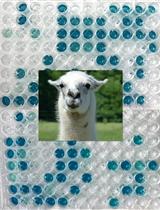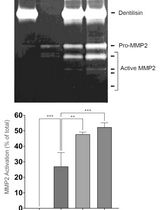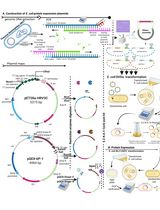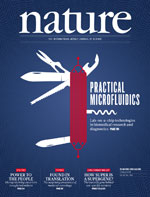- Submit a Protocol
- Receive Our Alerts
- Log in
- /
- Sign up
- My Bio Page
- Edit My Profile
- Change Password
- Log Out
- EN
- EN - English
- CN - 中文
- Protocols
- Articles and Issues
- For Authors
- About
- Become a Reviewer
- EN - English
- CN - 中文
- Home
- Protocols
- Articles and Issues
- For Authors
- About
- Become a Reviewer
Expression and Purification of the Thermus thermophilus Argonaute Protein
Published: Vol 4, Iss 19, Oct 5, 2014 DOI: 10.21769/BioProtoc.1253 Views: 10998
Reviewed by: Arsalan DaudiAnonymous reviewer(s)

Protocol Collections
Comprehensive collections of detailed, peer-reviewed protocols focusing on specific topics
Related protocols

From Llama to Nanobody: A Streamlined Workflow for the Generation of Functionalised VHHs
Lauren E.-A. Eyssen [...] Raymond J. Owens
Mar 20, 2024 6040 Views

Purification of Native Dentilisin Complex from Treponema denticola by Preparative Continuous Polyacrylamide Gel Electrophoresis and Functional Analysis by Gelatin Zymography
Pachiyappan Kamarajan [...] Yvonne L. Kapila
Apr 5, 2024 2023 Views

Thermus thermophilus CRISPR Cas6 Heterologous Expression and Purification
Junwei Wei [...] Yingjun Li
Jul 20, 2025 2089 Views
Abstract
The Argonaute protein of Thermus thermophilus (TtAgo) has recently been studied in detail. For its in vitro characterization, TtAgo was purified after heterologous expression in Escherichia coli (E. coli). As TtAgo expression is toxic, a tightly controlled system was used for protein expression. The expression strain E. coli KRX carries a chromosomal T7 RNA polymerase gene under control of a rhamnose promoter. The ago gene is expressed via an IPTG-inducible T7 promoter. This allows for tightly (double) controlled expression of (toxic) TtAgo. Here, we describe the steps required for controlled expression and purification of this toxic protein.
Materials and Reagents
- Expression of TtAgo in E. coli KRX
- Glycerol stock of Escherichia coli KRX (Promega corporation, catalog number: L3002 ) [encodes a T7 RNA polymerase gene under control of a rhamnose promoter], transformed with plasmids pRARE (EMD Millipore, plasmid of RosettaTM (DE3) Competent Cells, catalog number: 70954-3 ) [encodes tRNAs for rare codons to enhance protein translation efficiency] and pWUR702 [pCDF-1b derivative, with T. thermophilus HB27 TT_P0026 ago gene insert fused to an N-terminal strep(II)-tag, expression under control of an IPTG-inducible T7 promoter] (Addgene, catalog number: 53079 ).
Note: The plasmid pWUR703 (Addgene, catalog number: 53082 ) can be used for expression of TtAgoDM (Double Mutant, D478A, D546A). Expression and purification of this protein is identical to TtAgo expression and purification.
- 1,000x chloramphenicol solution (34 mg/ml) dissolved in 100% ethanol
- 1,000x streptomycin solution (50 mg/ml) dissolved in MilliQ H2O
- 20% D-glucose solution dissolved in MilliQ H2O (sterile filtered)
- 20% L-rhamnose solution dissolved in MilliQ H2O (sterile filtered)
- 1 M IPTG dissolved in MilliQ H2O (sterile filtered)
- LB medium (see Recipes)
- Glycerol stock of Escherichia coli KRX (Promega corporation, catalog number: L3002 ) [encodes a T7 RNA polymerase gene under control of a rhamnose promoter], transformed with plasmids pRARE (EMD Millipore, plasmid of RosettaTM (DE3) Competent Cells, catalog number: 70954-3 ) [encodes tRNAs for rare codons to enhance protein translation efficiency] and pWUR702 [pCDF-1b derivative, with T. thermophilus HB27 TT_P0026 ago gene insert fused to an N-terminal strep(II)-tag, expression under control of an IPTG-inducible T7 promoter] (Addgene, catalog number: 53079 ).
- Purification of TtAgo
- Cell pellet from o/n TtAgo expression (see above)
- Strep-Tactin Sepharose® 50% suspension (IBA, catalog number: 2-1201-XXX )
- 1.2 ml Bio-Spin® Chromatography Columns (Bio-Rad Laboratories, catalog number: 732-6008 )
- Buffer I (see Recipes)
- Buffer II (see Recipes)
- Buffer III (see Recipes)
- Cell pellet from o/n TtAgo expression (see above)
Equipment
- Expression of TtAgo in E. coli KRX
- 50 ml Greiner tube
- 2.5 L Erlenmeyer flask
- Centrifuge
- 37 °C shaker incubator
- 20 °C shaker incubator
- Ice-water bath (water and ice mixed)
- 50 ml Greiner tube
- Purification of TtAgo
- French-Press, sonicator, or equivalent for cell disruption
- Centrifuge
- French-Press, sonicator, or equivalent for cell disruption
Procedure
- Expression of TtAgo in E. coli KRX
- Take 10 ml LB medium in a 50 ml Greiner tube.
- Add 10 μl 1,000x chloramphenicol solution.
- Add 10 μl 1,000x streptomycin solution.
- Add 200 μl 20% D-glucose solution.
- Inoculate the culture from the glycerol stock using a sterile pipette tip.
- Incubate the culture o/n at 37 °C in a shaker incubator at 180 rpm.
- After o/n incubation, centrifuge culture for 10 min at 4,000 x g at room temperature.
- Remove the supernatant to remove any traces of D-glucose - this is important as D-glucose traces can prevent L-rhamnose uptake (and thereby represses TtAgo expression).
- Resuspend the cell pellet in 1 ml LB medium.
- Take a 2.5 L Erlenmeyer containing 1 L LB medium.
- Add 1 ml 1,000x chloramphenicol solution.
- Add 1 ml 1,000x streptomycin solution.
- Add resuspended cells.
- Incubate the culture at 37 °C in shaker incubator at 140 rpm.
- Monitor the OD600nm of the culture. If an OD600nm of 0.7-0.8 is reached (this takes ~3-4 h), transfer the culture to an ice-water bath to cold-shock it for 15 min. This step slows down the metabolism of E. coli and triggers expression of cold-shock proteins which may aid TtAgo folding during expression.
- Add 1 ml 1 M IPTG and 5 ml 20% L-rhamnose solution to the culture to induce expression.
- Transfer the culture to a 20 °C shaker incubator at 140 rpm for o/n (+/-16h) expression.
- Harvest the cells by centrifuging culture for 15 min at 6,000 x g at 4 °C.
- Remove the supernatant. You should typically end up with 4-5 grams of cell pellet.
- Take 10 ml LB medium in a 50 ml Greiner tube.
- Purification of TtAgo
- If using a French Press for cell lysis: Resuspend cell pellet in Buffer I (5 ml Buffer I per gram of cell pellet) and pass cell suspension through French press two times at 16,000 psi (see Note c).
If using a sonicator for cell lysis: Resuspend cell pellet in Buffer I (3 ml Buffer I per gram of cell pellet), and lyse the cells by sonication. Use a tip and sonication protocol suitable for lysis of large volume cell suspensions.
- Centrifuge for 30 min at 30,000 x g at 4 °C.
- Transfer the supernatant (cell free extract) to a clean tube.
- Prepare a Strep-Tactin Sepharose column by loading 500 μl of the 50% suspension in a 1.2 ml Bio-Spin chromatography column (final column volume is 250 μl).
- Wash column by loading the column three times with 500 μl Buffer I.
- Load the cell free extract on the column.
- Wash the column by loading it three times with 750 μl Buffer I.
- Wash the column by loading it three times with 750 μl Buffer II.
- Elute the protein by loading the column three times with 250 μl Buffer III, collect the flow through. Typical yields of TtAgo elution fractions are in the 0-2.5 μM range for fraction 1 and 3 and in the 5-10 μM range for fraction 2. Typical yields of TtAgoDM are in the 0-2.5 μM range for fraction 1 and 3 and in the 2.5-7.5 μM range for fraction 2.
Notes:- Depending on experiments, MgCl2 and MnCl2 concentrations can be lowered to 0.5 mM, or left out. NaCl concentration can be lowered to 0.5 M, however, TtAgo (especially at higher protein concentrations) is more stable at 1 M NaCl. At lower concentrations salt (especially bellow 250 mM), TtAgo is instable at protein concentrations higher than 5 μM).
- The protocol above describes purification of guide-free TtAgo. If guide co-purification is desired, replace all Buffer I in this experiment with Buffer II.
- Using a French Pressure cell or sonicator gives more or less the same yield – TtAgo is very stable and little to no protein will be lost during sonication. Keep in mind however, that sonication usually is less suitable for large volumes, and a protocol suitable for lysis of a large volume of cell suspension should be applied.
- Depending on experiments, MgCl2 and MnCl2 concentrations can be lowered to 0.5 mM, or left out. NaCl concentration can be lowered to 0.5 M, however, TtAgo (especially at higher protein concentrations) is more stable at 1 M NaCl. At lower concentrations salt (especially bellow 250 mM), TtAgo is instable at protein concentrations higher than 5 μM).
- If using a French Press for cell lysis: Resuspend cell pellet in Buffer I (5 ml Buffer I per gram of cell pellet) and pass cell suspension through French press two times at 16,000 psi (see Note c).
Representative data

Figure 1. Coomassie Brilliant Blue stained 12% SDS-PAGE gel of TtAgo (left) and TtAgoDM (right) purification samples. M: Bio-Rad precision plus protein marker. Marker band sizes are indicated in kDa. FT: Column flow through fraction of loaded cell free extract. W1: Column wash fraction with Buffer I. W2: Column wash fraction with Buffer II. EL1-EL3: Elution fractions 1-3. The protein appears as a band with a size of +/-75kDa.
Recipes
- LB medium (1 L)
10 g tryptone
5 g yeast extract
10 g NaCl
Fill up to 1 L with demiwater
Set pH to 7.5 with NaOH
- Buffer I
20 mM Tris-HCl (pH 8)
1 M NaCl
2 mM MgCl2
- Buffer II
20 mM Tris-HCl (pH 8)
1 M NaCl
2 mM MnCl2
- Buffer III
20 mM Tris-HCl (pH 8)
1 M NaCl
2 mM MnCl2
2.5mM Biotin
Note: Biotin can be replaced with d-Desthiobiotin, which will allow for column regeneration.
Acknowledgments
This work was financially supported by a grant from the Netherlands Organization of Scientific Research (NWO) to J.v.d.O. (NWO-TOP, 854.10.003).
References
- Swarts, D. C., Jore, M. M., Westra, E. R., Zhu, Y., Janssen, J. H., Snijders, A. P., Wang, Y., Patel, D. J., Berenguer, J., Brouns, S. J. and van der Oost, J. (2014). DNA-guided DNA interference by a prokaryotic Argonaute. Nature 507(7491): 258-261.
Article Information
Copyright
© 2014 The Authors; exclusive licensee Bio-protocol LLC.
How to cite
Swarts, D. C., Jore, M. M. and Oost, J. V. D. (2014). Expression and Purification of the Thermus thermophilus Argonaute Protein. Bio-protocol 4(19): e1253. DOI: 10.21769/BioProtoc.1253.
Category
Microbiology > Microbial biochemistry > Protein > Isolation and purification
Biochemistry > Protein > Isolation and purification
Biochemistry > Protein > Expression
Do you have any questions about this protocol?
Post your question to gather feedback from the community. We will also invite the authors of this article to respond.
Share
Bluesky
X
Copy link










